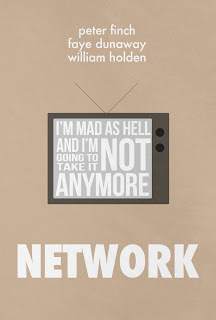
"I don't like the way this script of ours has turned out. It's turning into a seedy little drama"
Introduction
David Mamet and Aaron Sorkin surely watched this film hundreds of times before beginning their own careers. Indeed, Sorkin paid his respects to Network upon winning his Academy Award for The Social Network. Writer Paddy Chayefsky is one of only two screenwriters (alongside Woody Allen) to have won a Academy award for three films, as a solo writer. This film remains relevant and it is shockingly critical of television, cinema and media as a whole.
A Voice for the Audience
Howard Beale (Peter Finch) is an anchorman with failing ratings for his TV show. Realising he will be 'let go', he reveals - live on air - that he will kill himself. On TV. Next week. This single act sets in motion events that slowly reveal how sordid and spineless the TV station is - Beales popularity soars as his madness becomes a quasi-circus act as he preaches every night his attitude towards the problems in the world. Audiences lap it up and slowly, this crazed man becomes the most important man on TV. A product of the corruptness the media are happy to continue exploiting - especially as the success of Beale means success for the TV station, satisfying the demands of 'the money'; aka, the stakeholders.
Roger Ebert explains how, interestingly, though central to the story Howard Beale's madness and success is merely a 'macguffin', a story that really gives us a sense of context for the story of Diane Christiansen (Faye Dunaway), the "ratings hungry programming executive who is prepared to do anything for the numbers" as she begins a relationship with Max Schumacher (William Holden) as he realises the old-days are over and the new-class are taking over.
Tell Me About the Media
I would not be the first to wax-lyrical about the 'state of television' and how Network was clearly unaware of Jerry Springer, The X-Factor and Big Brother - you can find that easily enough on the internet. But it is interesting to compare the film to an equally shocking film directed by Spike Lee: Bamboozled.
Both satirical attacks on the media industry, Spike Lee manages to shock us with the depiction of racial stereotypes and the use of African-American images and ideas in the modern media. Though Sidney Lumet doesn't focus on the racial representation in the media, they both build to a climax whereby the outcome of the greed and immorality of the business itself results in a step too far - a TV-show that depicts black-face and obscene stereotypes and a decision to kill the performer live on air. Both films aspire to a realist-edge, Spike Lee using digital handheld cameras and behind-the-scenes sequences in Network add an air of authenticity. Both films don't feel too far from the truth. When we reflect on reality TV - and the moments whereby channels have apologised for the decisions to broadcast a situation (Jade Goody's racist tirade on the UK Big Brother, young Hollie Steel on Britains Got Talent), it can't be long before TV stations are held responsible for their actions. I think we could all easily stand up - ""I'M AS MAD AS HELL, AND I'M NOT GOING TO TAKE THIS ANYMORE!"
 The many, memorable speeches reflect attitudes that remain relevant in 2012 - a core speech details how everything is a part of one system and how dehumanising the world is. The bitter conflict surrounds the way the media needs to represent itself (its about you! its about informing you!) and what its actual objective is (Its about us. And we can only survive with money. From you). When you consider the recent phone scandals leading to the Leveson enquiry and you consider the awful truth behind Jimmy Saville in the UK ... the same conflict is at the center. The balance of morals under the pressure of capitalism - and the need to make money.
The many, memorable speeches reflect attitudes that remain relevant in 2012 - a core speech details how everything is a part of one system and how dehumanising the world is. The bitter conflict surrounds the way the media needs to represent itself (its about you! its about informing you!) and what its actual objective is (Its about us. And we can only survive with money. From you). When you consider the recent phone scandals leading to the Leveson enquiry and you consider the awful truth behind Jimmy Saville in the UK ... the same conflict is at the center. The balance of morals under the pressure of capitalism - and the need to make money.Change?
Joshua Klein writes in 1001 Movies to See Before You Die how Network is a "cynical treatise on the moral and ethical decline of television", going further by stating how it is "a damning portrayal of not just the television providers but us, the compulsive television viewers". It is and we are.
The change that Sidney Lumet, Spike Lee and others expect comes from us. We are the viewers and we dictate the creation of these programmes and whether they will continue. I would like to believe that the cynicism many have towards reality TV will continue - the pseudo-reality beginning to rub off and lose its edge. Big Brother changed its channel in the UK due to dwindling numbers - so the end is nigh. Klein also highlights how "sensationalism and tawdriness of TV is exactly what keeps us coming back", and maybe so. But celebrity culture [I hope] is perceived as cheap - and sporting icons in the Olympics celebrated and valued. I can only hope this continues to shape the media - and inspire a generation. Maybe we have stood up - and we're not taking it any more. Indeed, I'm not.










































